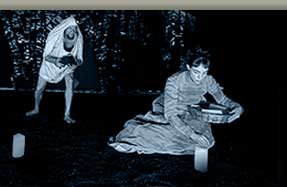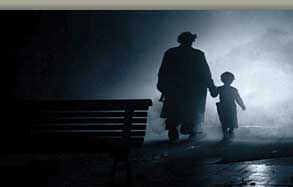





1.6 · FOUR VISIONS OF THEATRE: ANGÉLICA LIDDELL AND HER GENERATION
Por Ewelina Topolska
3. The enigma: Lluïsa Cunillé
Cunillé and Ripoll are representatives of two vey different approaches to theatre making, although their professional pathways crossed once when Ripoll directed a show based on Cunillé’s text, Barcelona, Map of Shadows (Barcelona, mapa de sombras) on the occasion of inauguration of the Franscisco Nieva Auditorium in the National Dramatic Centre in Madrid in 2006 [fig. 3]. This play, like a large share of this prolific writer’s production19, was written originally in Catalan (the playwright resides in Catalonia). Unlike Liddell and Ripoll, Cunillé does not venture into other areas of show production than writing20, but it is worth noting that two of her scripts have been made into films: February (Febrer, 2004) directed by Silvia Quer and Empty Spaces (Vacíos, 2004), basis for a short-film by Ignasi López-Serra. A large number of Cunillé’s plays have been put on stage by the Valencian Community-based theatre company L'Hongaresa, of which the author is a co-founder. Their story dates back to a February day in 1994, when Lola López21 brought Paco Zarzoso to a café at the França Station in Barcelona to introduce him to Cunillé (Puchades, 2015: 13). The first fruit of this acquaintance was a text co-authored by the two and directed by López, Inclement Weather (Intemperie), whose premiere took place in 1995. However, it was not Cunillé’s debut among a wider audience – that occurred earlier, with the play Rodeo, which in 1991 was awarded the Prize Calderón de la Barca, and in 1992 had its premiere in the, sadly no longer existing, National Centre of New Stage Tendencies in Madrid [fig. 4]. Since then the author has penned dozens of original plays and adaptations, creating an unmistakable personal brand which, in 2010, earned Cunillé the highest possible token of recognition in the world of Spanish drama, the prestigious National Dramatic Literature Award (for the play That Infinite Air22).
Among other plays that have called the attention of the audience and the critics alike we should mention Libration (Libración, 1994, Award of the Crticis of Barcelona 1993-94), Accident (1996, Award of the Institution of Catalan Literature 1997), Gutenberg Passatge (Passatge Gutenberg 2000, Award of the Critics of Barcelona 1999-2000), Anniversary (L'aniversari, Theatre Award Born 1999), Barcelona, Map of Shadows (Barcelona, mapa d'ombres 2004) and Aprés moi, le deluge (National Award of Catalan Theatre 2007, Award Golden Letter 2008 for the best play in Catalan language; premiered in Barcelona in 2007, converted into an opera in Spanish in 2017) [fig. 5].
What is so characteristic of these plays that the critics were tempted to invent a special term, Cunilléland (Spanish Cunillélandia) to refer to the peculiar universe (with its peculiar inhabitants) engendered in this author’s mind? Why cannot some make much sense of them23, whereas others hail Cunillé as the best dramaturge of the contemporary Spanish scene? Cunillé’s theatre is definitely not easy. Saturated with silences, neurotic misfits and awkward conversations, it keeps us suspended in a strange timeless limbo24, which does not seem to have any purpose or possible exit. Xavier Albertí affirms that Cunillé’s world “begins and ends in itself”; it’s a world that “resists a synopsis of the storyline25, which formulates interhuman relations that are displaced, removed from what the convention calls normal” (Albertí, 2008). These interhuman relations are devoid of complicity, of intimacy, of real comprehension, despite the fact that overcoming loneliness seems to be the Cunillé’s characters’ deepest longing. On the other hand, none of them seems to want it enough to engage in a real struggle; in fact, vehement passions and indomitable emotions are markedly absent from Cunilléland. If Eros, Freudian god of life and all its biophilic functions, dwells in some part of this playwright’s artistic universe, he must be old and too tired to set hearts ablaze. What is left when all burning desires have ceased to exist, the desires that give our lives a sense, a direction? What is left in a world deprived of trust, love and friendship? Routine, boredom, insipidness, mindless money-making, neurotic obsessions…in short, finding absurd or unhealthy substitutes for this meaning. Cunillé’s characters seem unable to overcome their oneness, and therefore their loneliness; unable to achieve real recognition by another human being, which renders themselves and their problems unreal, insignificant26. In Cunilléland even death seems yet another everyday occurrence27.
Indeed, the message, or should we say the mission that Cunillé embarked on, is very difficult to decipher. The author herself does not help, having taken a vow of silence at the beginning of her artistic career and keeping it with an admiration-inspiring consistency ever since (Cunillé never gives interviews or comments on her work; fullstop). The reader/spectator is left to her/his own devices to solve the enigma. Although in this case it is not guaranteed there is a solution.
19 An exhaustive list of Cunillé’s production until 2015 can be found in Ana Prieto Nadal’s doctoral thesis (2015, 67-69). Xavier Albertí, the playwright’s friend and regular director of her texts, reveals that the secret to the impressive number of plays Cunillé has produced lies in a strict discipline of writing 8 hours per day, and additionally, more than one play at a time (in Prieto Nadal, 2016, Anexo 1.10).
20 Which does not mean she is excluded from the process of staging her plays. In fact, Cunillé has a habit of observing assiduously all the rehearsals, even though she does not participate actively in the direction (Santos, 1999).
21 López, but especially Zarzoso, are multifaceted artists, taking on the roles of actors, directors and playwrights.
22 Although the very playwright expressed an opinion that most probably it is not the most significant of her plays (Torres, 2010).
23 To give an example, another Spanish playwright, Benet i Jornet, commented on the issue with these words: “I ignore what she aspires to, and I am writing for the moment when I’ll be able to penetrate the solemn look of some of her characters” (in Puchades 2005).
24 The term has been borrowed from Puchades (2005).
25 For this very reason I abstain from presenting the plot or the main theme of the enumerated plays.
26 Many aspects of Cunillé’s style can be traced back to her masters. In this regard Albertí identifies Chekhov, Ibsen, Robert Walser, Elias Canetti, Imre Kertész, Juan Carlos Onetti, Ionesco, Pasolini, Pitarra, Koltès, Bernhard, Valle-Inclán… (Albertí, 2008; Prieto Nadal, 2015, 55). Still, just as every gifted creator, she manages to construct a new, surprising whole out of old elements. Also, it is noteworthy that at some point Cunillé turned to exploring the traditional “small genre” (“género chico”) of Spanish musical comedy, which covers such forms as zarzuela, sainete (farce, titbit), operetta or revue. El dúo de la Africana (The Duet of ‘the African’ 2007), La corte del Faraón (Pharaoh’s Court 2008) and La Pajarera (The Aviary 2011) constitute examples of her modern rewritings of the traditional scripts.
27 The play that perfectly exemplifies this thesis is Après moi, le deluge.
![]()
Don Galán. Revista audiovisual de investigación teatral. | cdt@inaem.mecd.es | ISSN: 2174-713X | NIPO: 035160842
2018 Centro de Documentación Teatral. INAEM. Ministerio de Educación, Cultura y Deporte. Gobierno de España. | Diseño Web: Toma10
Inicio | Consejo de Redacción | Comité Científico | Normas de Publicación | Contacto | Enlaces